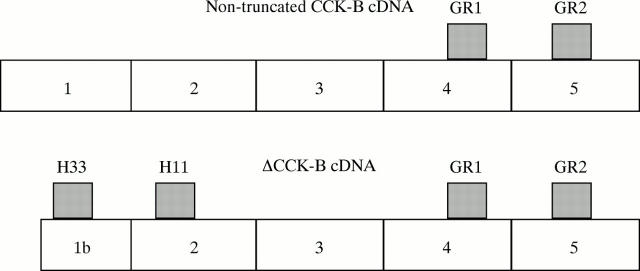Abstract
Background—The peptide hormone gastrin is a recognised growth factor for gastrointestinal (GI) tumour cells. Carboxyamidated gastrins bind to the cell surface gastrin/cholecystokinin B (CCK-B) receptor which can be expressed as either a normal or a truncated isoform (ΔCCK-B). Aims—To compare gastrin gene expression with ΔCCK-B and total CCK-B (both isoforms) gene expression in both GI and non-GI tract derived human tumour cell lines. Methods—Total RNA was extracted and gene expression was assayed by the reverse transcription-polymerase chain reaction followed by Southern blotting and hybridisation with specific oligo probes. Results—Gastrin was expressed by 5/5 gastric and 7/8 colorectal cell lines. Coexpression of gastrin CCK-B isoform was found in 80% of gastric and 75% of colorectal cell lines. Non-GI cell lines, with the exception of a lymphoblastic leukaemia cell line, showed no coexpression. The truncated receptor, ΔCCK-B, was shown in 3/5 gastric and 5/8 colorectal cell lines and was always coexpressed with gastrin. Conclusions—The truncated gastrin receptor, ΔCCK-B, is coexpressed with gastrin in 8/13 GI tumour cell lines. Gastrin and CCK-B receptor isoforms may be involved in maintaining autocrine/paracrine growth pathways in GI cancer cells.
Keywords: gastrin; CCK-B; ΔCCK-B; RT-PCR; gastrointestinal cell lines
Full Text
The Full Text of this article is available as a PDF (116.2 KB).
Figure 1 .
The "total CCK-B" RT-PCR assay using primers GR1 and GR2 detects both isoforms, while primers H33 and H11 specifically detect ΔCCK-B, the truncated CCK-B receptor.
Figure 2 .
(A) Southern blot of gastrin RT-PCR products from cell lines showing 215 bp and 345 bp bands. From left to right: AGS, A431, HT29(L), Colo205, 791T. (B) Southern blot of ΔCCK-B RT-PCR products showing a 281 bp band in those cell lines where it was detected. From left to right: HCT116, LIM1215, C170HM2, MCF-7B, AGS, AGS, MKN45, C170HM2, LoVo. (C) Southern blot of CCK-B RT-PCR products. From left to right: AGS, MCF-7B, HCT116, ST16 ascites.
Selected References
These references are in PubMed. This may not be the complete list of references from this article.
- Baldwin G. S., Casey A., Mantamadiotis T., McBride K., Sizeland A. M., Thumwood C. M. PCR cloning and sequence of gastrin mRNA from carcinoma cell lines. Biochem Biophys Res Commun. 1990 Jul 31;170(2):691–697. doi: 10.1016/0006-291x(90)92146-q. [DOI] [PubMed] [Google Scholar]
- Ciccotosto G. D., McLeish A., Hardy K. J., Shulkes A. Expression, processing, and secretion of gastrin in patients with colorectal carcinoma. Gastroenterology. 1995 Oct;109(4):1142–1153. doi: 10.1016/0016-5085(95)90572-3. [DOI] [PubMed] [Google Scholar]
- Hoosein N. M., Kiener P. A., Curry R. C., Brattain M. G. Evidence for autocrine growth stimulation of cultured colon tumor cells by a gastrin/cholecystokinin-like peptide. Exp Cell Res. 1990 Jan;186(1):15–21. doi: 10.1016/0014-4827(90)90204-n. [DOI] [PubMed] [Google Scholar]
- Ito M., Iwata N., Taniguchi T., Murayama T., Chihara K., Matsui T. Functional characterization of two cholecystokinin-B/gastrin receptor isoforms: a preferential splice donor site in the human receptor gene. Cell Growth Differ. 1994 Oct;5(10):1127–1135. [PubMed] [Google Scholar]
- Ito R., Sato K., Helmer T., Jay G., Agarwal K. Structural analysis of the gene encoding human gastrin: the large intron contains an Alu sequence. Proc Natl Acad Sci U S A. 1984 Aug;81(15):4662–4666. doi: 10.1073/pnas.81.15.4662. [DOI] [PMC free article] [PubMed] [Google Scholar]
- Iwata N., Murayama T., Matsumori Y., Ito M., Nagata A., Taniguchi T., Chihara K., Matsuo Y., Minowada J., Matsui T. Autocrine loop through cholecystokinin-B/gastrin receptors involved in growth of human leukemia cells. Blood. 1996 Oct 1;88(7):2683–2689. [PubMed] [Google Scholar]
- Matsushima Y., Kinoshita Y., Nakata H., Inomoto-Naribayashi Y., Asahara M., Kawanami C., Nakamura A., Ito M., Matsui T., Fujiwara T. Gastrin receptor gene expression in several human carcinomas. Jpn J Cancer Res. 1994 Aug;85(8):819–824. doi: 10.1111/j.1349-7006.1994.tb02953.x. [DOI] [PMC free article] [PubMed] [Google Scholar]
- McLaughlan J. M., Seth R., Vautier G., Robins R. A., Scott B. B., Hawkey C. J., Jenkins D. Interleukin-8 and inducible nitric oxide synthase mRNA levels in inflammatory bowel disease at first presentation. J Pathol. 1997 Jan;181(1):87–92. doi: 10.1002/(SICI)1096-9896(199701)181:1<87::AID-PATH736>3.0.CO;2-J. [DOI] [PubMed] [Google Scholar]
- Miyake A. A truncated isoform of human CCK-B/gastrin receptor generated by alternative usage of a novel exon. Biochem Biophys Res Commun. 1995 Mar 8;208(1):230–237. doi: 10.1006/bbrc.1995.1328. [DOI] [PubMed] [Google Scholar]
- Nègre F., Fagot-Revurat P., Bouisson M., Rehfeld J. F., Vaysse N., Pradayrol L. Autocrine stimulation of AR4-2J rat pancreatic tumor cell growth by glycine-extended gastrin. Int J Cancer. 1996 May 29;66(5):653–658. doi: 10.1002/(SICI)1097-0215(19960529)66:5<653::AID-IJC12>3.0.CO;2-5. [DOI] [PubMed] [Google Scholar]
- Seva C., Dickinson C. J., Yamada T. Growth-promoting effects of glycine-extended progastrin. Science. 1994 Jul 15;265(5170):410–412. doi: 10.1126/science.8023165. [DOI] [PubMed] [Google Scholar]
- Varro A., Voronina S., Dockray G. J. Pathways of processing of the gastrin precursor in rat antral mucosa. J Clin Invest. 1995 Apr;95(4):1642–1649. doi: 10.1172/JCI117839. [DOI] [PMC free article] [PubMed] [Google Scholar]
- Wank S. A. Cholecystokinin receptors. Am J Physiol. 1995 Nov;269(5 Pt 1):G628–G646. doi: 10.1152/ajpgi.1995.269.5.G628. [DOI] [PubMed] [Google Scholar]
- Watson S. A., Michaeli D., Grimes S., Morris T. M., Robinson G., Varro A., Justin T. A., Hardcastle J. D. Gastrimmune raises antibodies that neutralize amidated and glycine-extended gastrin-17 and inhibit the growth of colon cancer. Cancer Res. 1996 Feb 15;56(4):880–885. [PubMed] [Google Scholar]
- Yoshida K., Bolodeoku J., Sugino T., Goodison S., Matsumura Y., Warren B. F., Toge T., Tahara E., Tarin D. Abnormal retention of intron 9 in CD44 gene transcripts in human gastrointestinal tumors. Cancer Res. 1995 Oct 1;55(19):4273–4277. [PubMed] [Google Scholar]
- van Solinge W. W., Rehfeld J. F. Co-transcription of the gastrin and cholecystokinin genes with selective translation of gastrin mRNA in a human gastric carcinoma cell line. FEBS Lett. 1992 Aug 31;309(1):47–50. doi: 10.1016/0014-5793(92)80736-z. [DOI] [PubMed] [Google Scholar]




